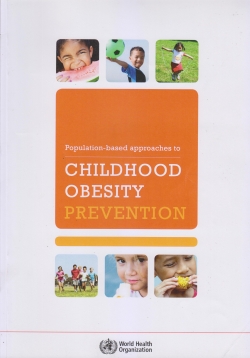Population-based approaches to childhood obesity prevention

Buy online ($)
Type
Book
Authors
ISBN 13
9789241504782
Category
Publication Year
2012
Publisher
Pages
52
Subject
Obesity--Prevention and control ; Obesity in children
Description
The United Nations Political Declaration of the High-level Meeting of the General Assembly on the Prevention and Control of Non-communicable Diseases and the World Health Organization (WHO) Global Strategy on Diet, Physical Activity and Health both identify population-based prevention as being vital to addressing rising levels of noncommunicable diseases, with specific emphasis on childhood obesity.
As part of its commitment to providing technical advice to Member States in implementing the Global Strategy on Diet, Physical Activity and Health, WHO held a Forum and Technical Meeting on Population-based Prevention Strategies for Childhood Obesity in 2009. The overall aim of the Forum and Meeting was to identify priorities for population-based strategies to prevent childhood obesity,
and to define roles and responsibilities for various stakeholders. As a follow-up to the Meeting, WHO was asked to develop a tool for Member States to determine and identify priority areas for action, and also develop examples of population-based approaches to preventing childhood obesity.
This document addresses the latter of these requests and aims to provide Member States with an overview of the types of childhood obesity prevention interventions that can be undertaken at national, sub-national and local levels. Where relevant, the document also aims to indicate which prevention measures are likely to be the most effective. The document first outlines guiding principles for the development of a population-based childhood obesity prevention strategy. It is clear that actions to prevent childhood obesity need to be taken in multiple settings and at all levels of government. They also need to incorporate a variety of approaches and involve a wide range of stakeholders. Moreover, childhood obesity prevention
efforts need to be tightly integrated with other efforts to control the major noncommunicable disease risk factors. Policies for obesity prevention need to be inclusive and improve equity, with interventions tailored to suit local contexts. They also need to be carried out in a transparent and sustainable way. Surveillance, monitoring and evaluation are also critical to support effective action. The prioritization of policy actions needs to be explicit, with defined processes for selecting interventions for implementation in a step-based manner. Approaches for population-based obesity prevention can be divided into three broad components:
The first component is the structures within government to support childhood obesity prevention policies and interventions. These are structural aspects such as leadership, “health-in-all” policies, dedicated funding for health promotion, noncommunicable disease monitoring systems, workforce capacity, and networks and partnerships that need to be in place in order to support and enhance the effectiveness of the more direct policy initiatives and community-based interventions. The second component is population-wide policies and initiatives. These are direct policy actions that help to create environments that support healthy diets and physical activity. The types of policy instruments typically used as part of this component of a comprehensive childhood obesity prevention strategy are laws and regulations, taxes and subsidies, and social marketing campaigns
that affect the population as a whole (or large population groups). Policies influencing food environments that are likely to be effective interventions include restrictions on the marketing of unhealthy foods and non-alcoholic beverages to children, nutrition labelling, and food taxes and subsidies. Policies influencing physical activity environments that have been demonstrated as effective include environmental interventions targeting the built environment, policies that reduce
12 barriers to physical activity, transport policies, policies to increase space for recreational activity, and school-based physical activity policies. The third component is community-based interventions. These are multi-component interventions and programmes, typically applied across multiple settings, tailored to the local environment and implemented locally. Best practice principles for designing and implementing community-based interventions include strong community engagement at all stages of the process, careful planning of
interventions to incorporate local information, and integration of the programme into other initiatives in the community. Community-based interventions have been demonstrated to be successful when applied in multiple settings, including early childcare settings, schools and other community settings. Importantly, single-component interventions may still form an important part of a step-based approach to obesity prevention – for example as the first step in implementing a multi-component, multi-setting intervention programme. In summary, there is a broad range of population-level actions that governments can take to prevent childhood obesity. A comprehensive childhood obesity prevention strategy will incorporate
aspects of each of the key components. Strategic investment is required to implement effective and culturally appropriate population-based childhood obesity prevention programmes and initiatives, and to ensure that they include vulnerable groups, such as children with disabilities. It is essential that such interventions occur across the whole population, in a variety of settings, and through multiple strategies.
As part of its commitment to providing technical advice to Member States in implementing the Global Strategy on Diet, Physical Activity and Health, WHO held a Forum and Technical Meeting on Population-based Prevention Strategies for Childhood Obesity in 2009. The overall aim of the Forum and Meeting was to identify priorities for population-based strategies to prevent childhood obesity,
and to define roles and responsibilities for various stakeholders. As a follow-up to the Meeting, WHO was asked to develop a tool for Member States to determine and identify priority areas for action, and also develop examples of population-based approaches to preventing childhood obesity.
This document addresses the latter of these requests and aims to provide Member States with an overview of the types of childhood obesity prevention interventions that can be undertaken at national, sub-national and local levels. Where relevant, the document also aims to indicate which prevention measures are likely to be the most effective. The document first outlines guiding principles for the development of a population-based childhood obesity prevention strategy. It is clear that actions to prevent childhood obesity need to be taken in multiple settings and at all levels of government. They also need to incorporate a variety of approaches and involve a wide range of stakeholders. Moreover, childhood obesity prevention
efforts need to be tightly integrated with other efforts to control the major noncommunicable disease risk factors. Policies for obesity prevention need to be inclusive and improve equity, with interventions tailored to suit local contexts. They also need to be carried out in a transparent and sustainable way. Surveillance, monitoring and evaluation are also critical to support effective action. The prioritization of policy actions needs to be explicit, with defined processes for selecting interventions for implementation in a step-based manner. Approaches for population-based obesity prevention can be divided into three broad components:
The first component is the structures within government to support childhood obesity prevention policies and interventions. These are structural aspects such as leadership, “health-in-all” policies, dedicated funding for health promotion, noncommunicable disease monitoring systems, workforce capacity, and networks and partnerships that need to be in place in order to support and enhance the effectiveness of the more direct policy initiatives and community-based interventions. The second component is population-wide policies and initiatives. These are direct policy actions that help to create environments that support healthy diets and physical activity. The types of policy instruments typically used as part of this component of a comprehensive childhood obesity prevention strategy are laws and regulations, taxes and subsidies, and social marketing campaigns
that affect the population as a whole (or large population groups). Policies influencing food environments that are likely to be effective interventions include restrictions on the marketing of unhealthy foods and non-alcoholic beverages to children, nutrition labelling, and food taxes and subsidies. Policies influencing physical activity environments that have been demonstrated as effective include environmental interventions targeting the built environment, policies that reduce
12 barriers to physical activity, transport policies, policies to increase space for recreational activity, and school-based physical activity policies. The third component is community-based interventions. These are multi-component interventions and programmes, typically applied across multiple settings, tailored to the local environment and implemented locally. Best practice principles for designing and implementing community-based interventions include strong community engagement at all stages of the process, careful planning of
interventions to incorporate local information, and integration of the programme into other initiatives in the community. Community-based interventions have been demonstrated to be successful when applied in multiple settings, including early childcare settings, schools and other community settings. Importantly, single-component interventions may still form an important part of a step-based approach to obesity prevention – for example as the first step in implementing a multi-component, multi-setting intervention programme. In summary, there is a broad range of population-level actions that governments can take to prevent childhood obesity. A comprehensive childhood obesity prevention strategy will incorporate
aspects of each of the key components. Strategic investment is required to implement effective and culturally appropriate population-based childhood obesity prevention programmes and initiatives, and to ensure that they include vulnerable groups, such as children with disabilities. It is essential that such interventions occur across the whole population, in a variety of settings, and through multiple strategies.
Number of Copies
1
| Library | Accession No | Call No | Copy No | Edition | Location | Availability |
|---|---|---|---|---|---|---|
| Main | 974 | RJ 399 C6 P6 | 1 | Yes |




